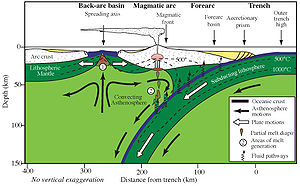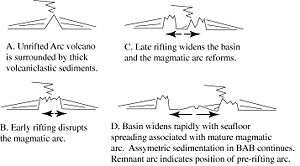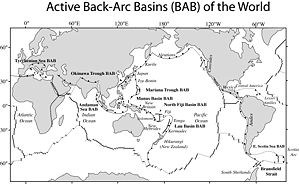
Back-arc basin
Encyclopedia

Island arc
An island arc is a type of archipelago composed of a chain of volcanoes which alignment is arc-shaped, and which are situated parallel and close to a boundary between two converging tectonic plates....
s and subduction zones.
They are found at some convergent plate boundaries
Convergent boundary
In plate tectonics, a convergent boundary, also known as a destructive plate boundary , is an actively deforming region where two tectonic plates or fragments of lithosphere move toward one another and collide...
, presently concentrated in the Western Pacific ocean
Pacific Ocean
The Pacific Ocean is the largest of the Earth's oceanic divisions. It extends from the Arctic in the north to the Southern Ocean in the south, bounded by Asia and Australia in the west, and the Americas in the east.At 165.2 million square kilometres in area, this largest division of the World...
. Most of them result from tensional forces caused by oceanic trench
Oceanic trench
The oceanic trenches are hemispheric-scale long but narrow topographic depressions of the sea floor. They are also the deepest parts of the ocean floor....
rollback and the collapse of the edge of the continent. Back-arc basins were not predicted by plate tectonics
Plate tectonics
Plate tectonics is a scientific theory that describes the large scale motions of Earth's lithosphere...
theory, but they are consistent with this model for how the Earth
Earth
Earth is the third planet from the Sun, and the densest and fifth-largest of the eight planets in the Solar System. It is also the largest of the Solar System's four terrestrial planets...
loses heat.

Characteristics
Back-arc basins are typically very long (several hundreds to thousands of kilometers) and relatively narrow (a few hundred kilometers). The restricted width of back-arc basins is probably because magmatic activity depends on water and induced mantle convection and these are both concentrated near the subduction zone. Spreading rates vary from very slow spreading (Mariana TroughMariana Trough
The Mariana Trough is an active back-arc basin in the western Pacific Ocean . It is an integral part of the Izu-Bonin-Mariana Arc system.-Location and Bathymetry:...
), a few centimeters per year, to very fast (Lau Basin
Lau Basin
The Lau Basin is an oceanic basin between the Pacific Plate and the Indo-Australian Plate by the Tonga Islands in the southwest Pacific. It is a relatively shallow basin between the islands and atoll feefs of the Lau Ridge/Lau Islands in the west and the Tonga Ridge/Tonga Islands and Tofua Arc in...
), 15 cm/year. These ridges erupt basalt
Basalt
Basalt is a common extrusive volcanic rock. It is usually grey to black and fine-grained due to rapid cooling of lava at the surface of a planet. It may be porphyritic containing larger crystals in a fine matrix, or vesicular, or frothy scoria. Unweathered basalt is black or grey...
s that are similar to those erupted from the mid-ocean ridges; the main difference is that back-arc basin basalts are often very rich in magmatic water
Magmatic water
Magmatic water or juvenile water is water which exists within and in equilibrium with a magma or water rich volatile fluids which are derived from a magma. This magmatic water is released to the atmosphere during a volcanic eruption...
(typically 1-1.5 weight % H2O), whereas mid-ocean ridge basalt magmas are very dry (typically <0.3 weight % H2O). The high water contents of back-arc basin basalt magmas is derived from water carried down the subduction zone and released into the overlying mantle wedge. Additional source of water could be the eclogitization
Eclogite
Eclogite is a mafic metamorphic rock. Eclogite is of special interest for at least two reasons. First, it forms at pressures greater than those typical of the crust of the Earth...
of amphiboles and mica
Mica
The mica group of sheet silicate minerals includes several closely related materials having highly perfect basal cleavage. All are monoclinic, with a tendency towards pseudohexagonal crystals, and are similar in chemical composition...
s in the subducting slab. Similar to mid-ocean ridges, back-arc basins have hydrothermal vent
Hydrothermal vent
A hydrothermal vent is a fissure in a planet's surface from which geothermally heated water issues. Hydrothermal vents are commonly found near volcanically active places, areas where tectonic plates are moving apart, ocean basins, and hotspots. Hydrothermal vents exist because the earth is both...
s and associated chemosynthetic communities.

Asymmetry
Back-arc basins are different from normal mid-ocean ridgeMid-ocean ridge
A mid-ocean ridge is a general term for an underwater mountain system that consists of various mountain ranges , typically having a valley known as a rift running along its spine, formed by plate tectonics. This type of oceanic ridge is characteristic of what is known as an oceanic spreading...
s because they are characterized by asymmetric seafloor spreading
Seafloor spreading
Seafloor spreading is a process that occurs at mid-ocean ridges, where new oceanic crust is formed through volcanic activity and then gradually moves away from the ridge. Seafloor spreading helps explain continental drift in the theory of plate tectonics....
, but this is quite variable even within single basins. For example in the central Mariana Trough current spreading rates are 2-3 times greater on the western flank whereas at the southern end of the Mariana Trough the position of the spreading center adjacent to the volcanic front suggests that overall crustal accretion has been nearly 100% asymmetric there. This situation is mirrored to the north where a large spreading asymmetry is also developed. Other back-arc basins such as the Lau Basin have undergone large rift jumps and propagation events that have transferred spreading centers from arc-distal to more arc-proximal positions although recent spreading rates appear to be relatively symmetric with perhaps small rift jumps. The cause of asymmetric spreading in back-arc basins remains poorly understood. General ideas invoke asymmetries relative to the spreading axis in arc melt generation processes and heat flow, hydration gradients with distance from the slab, mantle
Mantle (geology)
The mantle is a part of a terrestrial planet or other rocky body large enough to have differentiation by density. The interior of the Earth, similar to the other terrestrial planets, is chemically divided into layers. The mantle is a highly viscous layer between the crust and the outer core....
wedge effects, and evolution from rifting to spreading.
Formation and sedimentation
Back-arc basins are hypothesized to form as a result of a process termed trench rollback (also, hinge rollback). This term describes the backward motion of the subduction zone relative to the motion of the plate which is being subducted. As the subduction zone and its associated trench pull backward, the overriding plate is stretched, thinning the crust which is manifest in the back-arc basin. Sedimentation is strongly asymmetric, with most of the sediment supplied from the active magmatic arc which regresses in step with the rollback of the trench.
Location
Active back-arc basins are found in the Marianas, Tonga-Kermadec, S. Scotia, Manus, N. Fiji, and Tyrrhenian SeaTyrrhenian Sea
The Tyrrhenian Sea is part of the Mediterranean Sea off the western coast of Italy.-Geography:The sea is bounded by Corsica and Sardinia , Tuscany, Lazio, Campania, Basilicata and Calabria and Sicily ....
regions, but most are found in the Western Pacific. Not all subduction zones have back-arc basins, some like the central Andes are associated with rear-arc compression. In addition, there are a number of extinct or fossil back-arc basins, such as the Parece Vela-Shikoku Basin, Sea of Japan
Sea of Japan
The Sea of Japan is a marginal sea of the western Pacific Ocean, between the Asian mainland, the Japanese archipelago and Sakhalin. It is bordered by Japan, North Korea, Russia and South Korea. Like the Mediterranean Sea, it has almost no tides due to its nearly complete enclosure from the Pacific...
, and Kurile Basin.
The Black Sea
Black Sea
The Black Sea is bounded by Europe, Anatolia and the Caucasus and is ultimately connected to the Atlantic Ocean via the Mediterranean and the Aegean seas and various straits. The Bosphorus strait connects it to the Sea of Marmara, and the strait of the Dardanelles connects that sea to the Aegean...
formed from two separate back-arc basins.
History of thought
With the development of plate tectonic theory, geologists thought that convergent plate margins were zones of compression, thus zones of strong extension above subduction zones (back-arc basins) were not expected. The hypothesis that some convergent plate margins were actively spreading was developed by Dan Karig (1970) while a graduate student at the Scripps Institution of OceanographyScripps Institution of Oceanography
Scripps Institution of Oceanography in La Jolla, California, is one of the oldest and largest centers for ocean and earth science research, graduate training, and public service in the world...
. This resulted from several marine geologic expeditions to the Western Pacific.

